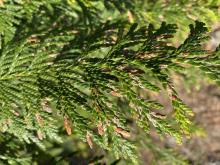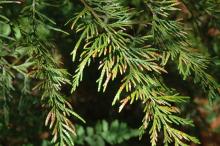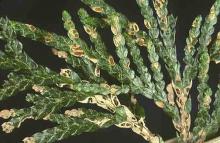Cause Didymascella thujina, a fungus. Although the disease is found mostly in warm-moist environments typical of coastal low elevations of the Pacific Northwest, the pathogen is endemic to North America and found throughout the natural range of western red cedar. Spore discharge from wetted apothecia begins in late spring and increases gradually during the summer, reaching a peak between late August and early November. In the PNW, there may be little inoculum during the annual summer drought but a second ascospore release can occur in the fall if conditions are wet and above 50°F. Spores' stickiness helps them adhere to foliage. Spores produced in the summer can germinate in a few days, but many produced in fall remain dormant until the next spring. Conditions that keep foliage wet, aid disease development and spread. Symptoms develop the season after spore dispersal. Trees and shrubs of all age classes are attacked whether in nurseries, landscapes or forests. However, seedlings are most severely affected. The disease is found primarily on western red cedar (Thuja plicata), especially the cultivars Atrovirens and Excelsa.
Can also be confused with the minor problem caused by Pseudocercospora thujina (formerly Coryneum thujinum).
Coastal areas of British Columbia report a high incidence of a distinctive type of blight caused by Truncatella angustata from late May to early December.
Symptoms Small, bleached spots on the upper surface of one-year-old leaves appear first. One or several brown to black fruiting structures (apothecia) appear on the small leaves in late spring. Leaves turn brown and drop in fall. Infected leaves that remain on the tree turn ashy gray. Apothecia are imbedded in leaf tissues; the entire structure drops out, leaving deep pits. The disease progression gives the appearance of having been scorched by fire.
Truncatella angustata - Early symptoms appeared as circular to oval, brownish to black spots (2 to 3 mm), with 1 to 5 spots per branch tip, scattered at the tip margins. Sequentially, the spots enlarged and developed into necrotic lesions on both young and old leaves.
Cultural control
- Propagate from disease-free stock plants.
- Use seed from British Columbia coastal, low-elevation populations.
- Space nursery plants and time irrigation to promote rapid drying of foliage.
- Do not grow susceptible cultivars downwind of infected hedges, windbreaks, or nearby stands of native western red cedar.
- Pruning out and burning affected twigs is of limited use.
- Remove plant debris from seed before seeding.
Chemical control Apply during wet periods in spring and fall to protect healthy foliage.
- Banner MAXX at 5 to 8 fl oz/100 gal water can be used if not phytotoxic to plants. Topas (propiconazole) is registered in British Columbia for use every 4 weeks during the growing season to a maximum of six (6) applications. Group 3 fungicide. 12-hr reentry.
- Bordeaux or fixed-copper sprays (such as CuPRO 5000 at 1.5 to 2 lb/A) in spring and early summer. 48-hr reentry. O
- Mancozeb-based products. British Columbia recommends regular sprays from late March through May and again from late August through October. Group M3 fungicides. 24-hr reentry.
- Fore 80 WP at 1.5 lb/100 gal water plus a spreader-sticker.
- Protect DF at 1 to 2 lb/100 gal water plus 2 to 4 oz spreader-sticker.
- Tebuject 16 is registered for tree injections. The number of capsules used is based on tree size.
References Gray, L.K., Russell, J.H., Alvin D., Yanchuk, A.D., and Hawkins, B.J. 2013. Predicting the risk of cedar leaf blight (Didymascella thujina) in British Columbia under future climate change. Agricultural and Forest Meteorology 180:152-163.
Noshad, D., van der Merwe, L. and Yanchuk, A. 2024. First Report of Truncatella angustata Causing Leaf Blight on Thuja plicata in Canada. Plant Disease Note, 108:785.
Russell, J.H., Kope, H.H., Ades, P., and Collinson, H. 2007. Variation in cedar leaf blight (Didymascella thujina) resistance of western redcedar (Thuja plicata). Canadian Journal of Forest Research 37:1978-1986.



